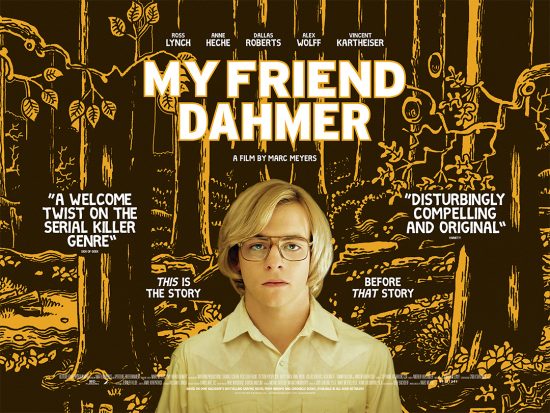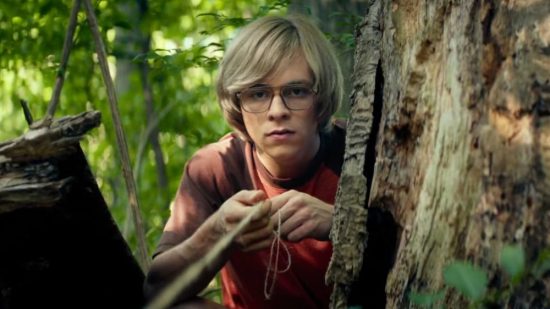Review & Interview: Inside My Friend Dahmer with filmmaker Marc Meyers
A compelling character study oozing with razor-sharp tension from start to finish, the best way to fully appreciate the nuances behind My Friend Dahmer would be the total lack of awareness about its subject matter. Yet, even if you’re well acquainted with the gruesome details of Jeffrey Dahmer’s 17 murders of men and boys in the Midwest United States between 1978 and 1991, the coming of age story of the most infamous serial killer since Jack the Ripper will still surprise you and will haunt you for days after credits roll.
Filmmaker Marc Meyers has done some outstanding work here both as a writer adapting Derf Backderf’s brilliant graphic novel of the same name and as a visual storyteller, directing the period piece with style, confidence, sensibility and an objective approach to the delicate and complex subject matter. And his vision was vividly brought to life by a flawless cast led by former Disney Channel star Ross Lynch who delivers a revelatory performance in the titular role, worthy of an Oscar nomination.
Although the narrative explores how and why Dhamer grew up to become the monster we’ve learned about in the news, Meyers never tries to answer the eternal human debate of nature versus nurture as he’s more interested in pushing the audience to reflect upon those questions on their own. The result is a compassionate yet unflinching, hypnotic and extremely taut look at the rise of the Ohio-native fiend with a spruce of a Dexter feel and a sense of overwhelming sadness.
When we met the talented filmmaker at the BFI London Film Festival for My Friend Dahmer’s European premiere back in October, he immediately pointed out how the film leans towards the idea that the answer to that main question lies in the middle: “viewers will hopefully agree that you can’t point the finger at one singular reason why anyone does anything, good or bad. I think that it’s always a mix of inner and outer problems and a whole host of forces that contribute to something. In this case there are so many things going on in Dahmer’s character and it’s the combination of all these things which affects him in the end, so no one can be blamed but everyone can say they had some part around what he became.”
From the very opening sequence, we realise that Jeffrey Dahmer is more than just an introverted teenager: he’s one who’s disconnected from the world around him. Riding the school bus, he’s looking out the window and his attention is grabbed first by road kill and then by a jogger on the side of the road, whom he can’t stop staring at, even when the bus overtakes the man. On the surface, Jeff is living just your average suburban teen life but it’s immediately obvious he’s an extremely lonely young man who’s sinking deeper and deeper into isolation.
It takes a quick introduction to his family life to figure out that the boy doesn’t find any solace at home. His chemist father (Dallas Roberts), a stern man absorbed by his work, keeps hustling Jeffrey about getting out of his shell to make friends, whilst his mentally unstable mother (Anne Heche), when not throwing some fit, seems more focused on Jeffrey’s younger brother. The couple can’t stop arguing and the unbearable constant tension has evidently started to weigh on Jeffrey’s already fragile psyche.
Whilst his peers spend time doing typical silly teenage stuff, Jeffrey collects road kill, which he takes to a shed in the woods to drop it in acid and get to the bones, eerily claiming to be curious about what their insides look like. Add to that his continuous stalking of the male jogger (Vincent Kartheiser) around his neighbourhood and soon daydreaming about the man lying dead in his bed, and you get a complete picture that something disturbing is bubbling beneath the surface.
When his father has enough of Jeffrey’s misanthropy to the point of breaking into the shed and trashing all the chemical stuff he had provided his son within the first place, Jeffrey has no choice but make a social effort. Inspired by his mother’s flamboyant and cerebral-palsy-afflicted interior decorator, Jeffrey comes up with this over the top impression of the man’s spastic antics, which he randomly breaks out in the middle of the school hallway one day. The goofy act grabs the attention of cartoonist Derf (Alex Wolff) and his clan of nerdy jokers who welcome Jeffrey into their group, making his act the centrepiece of their pranks and even creating a “Dahmer fan club” complete with Derf’s caricature drawings of Jeffrey.
Derf Backderf, here perfectly portrayed by rising star Alex Wolff, has grown up to become an award-winning cartoonist and graphic novel author/artist whose world was shaken the day he found out the horrifying acts committed by his former schoolmate. He and his group of friends had not seen Dahmer since high school graduation when their relationship with him had progressively dissipated. As chronicled in the film, Dahmer’s inward inclination during his senior year only intensifies after his parents get into a nasty divorce and his darkness keeps swallowing him, exacerbated by his downward spiral into alcoholism.
The boy’s lack of empathy and disconnection from the world around him grow stronger, his new friends notice that something’s off about him and naturally let him slip out of their entourage like it happens at that age, although it’s hard to tell when their indifference ends and Dahmer’s own drifting away begins. That’s the greatest achievement of the film: no judgment is cast and no finger is pointed but facts are reconstructed with inevitable creative license, based on Derf’s account in his superb graphic novel.
The filmmaker reflected on how there’s a little bit of catharsis in the source material but the author has enough distance with the book: “Even I who wasn’t there but was trying to recreate being there, can feel that there was no one to blame though the entire culture was at the same time unknowingly allowing this to be fed and fostered. Dahmer’s mixing of proclivities and of ghastly urges and the evil that may be there within him had a place to go and part of that is because the environment around him didn’t reach out with a loving hand and at the same time he couldn’t stop.”
Having read the graphic novel after our conversation with the filmmaker, we can confirm that Meyers has done a pristine work of adaptation where entire panels are faithfully re-created on screen and the necessary narrative tweaks work wonders for the cinematic version of the story. Reading the book is something we highly recommend after watching the film and as you do that, it’s impossible not to wonder what kind of experience must’ve been for the author to revisit his formative years and re-process it all after learning about Dahmer’s dark fate.
Meyers highlighted how Derf, as a storyteller amongst his friends, recognised he had a responsibility to share a story that fell in his lap because he happened to be the childhood friend of a serial killer: “What prevents it from becoming a mess is that the artist knows structurally how to communicate it to other people so that they can also get something emotional from it. It was something unforeseen and, even when he got the news about Jeffrey’s arrest, it took him many years to process it and do a first draft and then to revisit it when he wasn’t satisfied with his first pass until it became this book. So it was a 25 year journey for him on top of me for 5 years trying to make a film based on his book.”
Backderf gave comments on the script, understanding the need for creative license when adapting a book into a movie. Yet he was a huge champion of the film and he’s been so supportive that now there’s a movie tie-in version of his graphic novel for which the director wrote an introduction and shared several behind the scenes photographs from the making of the movie: “Derf said that it’s one of the most loyal adaptations of a graphic novel that’s come out in a very long time so he’s very proud as it feels like it captures the emotions which he and his friends were feeling at that time. Getting that blessing from Derf was a sigh of relief and it’s great to be connected with him and his journey.”
The collaboration between the director and the author wasn’t just limited to story approval. After Meyers wrote the first draft of the script he stayed with Derf in his house in Cleveland, which is only a 45 min drive North from Bath, where the author grew up. They drove there a couple of days and went around Derf’s high school, the woods, his childhood home and some of his friends’ houses. They eventually wound up at Jeffrey’s house and the owner showed them around since it’s a small Ohio community and he was a friend of a friend of Derf’s.
Being able to visit Dahmer’s childhood home and then wind up filming there was priceless for the filmmaker: “I’m someone who responds to place a lot as it gives my writing a lot of detail and informs my creative process. Bringing the cast and actually being able to film there was the cherry on top. Giving extra meaning, truth and honesty to what we were trying to do was amazing cause the one thing I didn’t want to do was exploit. Even if the story is about someone who’d potentially be evil, I wanted to be honest with what his experience was like and so in the pursuit of authenticity it felt like it was unquestionably the place I had to go and bring the film to and then that determined everything else. We had to find a high school nearby, we went to the woods where they hung out and filmed on the roads they drove on.”
One of Meyers’ merits in directing this origin story that chronicles the birth of the infamous gay serial killer is the ability to engage and entertain the audience with a disturbing story without ever recurring to any form of sensationalism. My Friend Dahmer is practically devoid of physical violence yet manages to chill the blood in our veins with the incredible level of pathos that relentlessly builds up around the protagonist and its tormented psyche. It’s also a film that couldn’t be anymore timely when it comes to social commentary and the current state of the average American high school.
Besides his inspired work directing actors and seamlessly recreating the era’s mood with a crafty blend of production design, costumes and gorgeous cinematography, Meyers’ key achievement is the screenplay, which was featured in the 2014 edition of the Blacklist, Hollywood’s yearly collection of the most loved unproduced scripts. We wrapped our conversation with the filmmaker asking how it all came about: “The script was the letter that went in the mail to people and made them want to be on board. If the script connects with people, then they feel like it’s more than just a job. And it’s the same when approaching actors. I might not know an actor but if they connect with the script then they want to know more about the project rather than the paycheck, which we’ll we worry about afterwards.”
There were some other producers who came on board and were champions of the project and helped out to find the money and resources and other talent and helped Meyers root into the Ohio community to find some collaborators from that area that really gave the movie that level of authenticity he was striving for: “Some scripts can be beautifully written but maybe have to go through other thresholds to get made. We were just focused on making it a reality and that’s part of it, you have to not find reasons to allow it to not happen and it’s so much easier in life for people to say no than to say yes. You just go out there to find the doors that are open and make sure those are the good doors to go through, cause sometimes you go through a door and you realise it’s not good that you entered that space cause it’s wasting your time and your money. It’s a struggle but we navigated and we found some really good people who supported the project all the way through. I will just say that my producer (and wife) Jody Girgenti and my other producing partner were very tenacious from the beginning about seeing this was a very special story that we had to tell for our careers but also because we felt a responsibility to telling it.”
My Friend Dahmer is released in UK cinemas and on digital 1st June.















